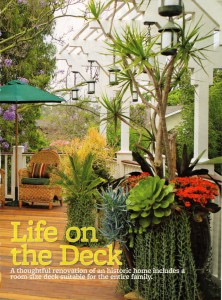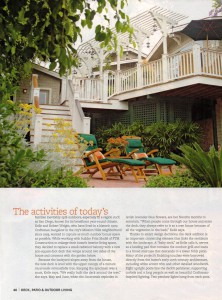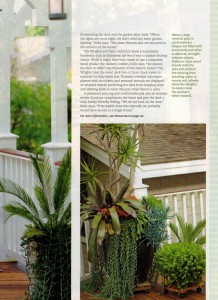Life on the Deck
A thoughtful renovation of an historic home includes a room-size deck suitable for the entire family.
By Debra Prinzing | Photography by Ed Gohlich | Produced by Andrea Caughey
BH&G's Deck, Patio & Outdoor Living | Spring 2013

One area of the new deck accommodates a seating area that overlooks the distant canyon. Multiple posts support a beautiful pergola with corbels that echo the home’s detailed millwork and enclose the deck, giving it a room-like feeling of scale.
In 1909, when the original owners of a Craftsman bungalow in San Diego’s Mission Hills neighborhood moved in, they probably didn’t grill chicken on the barbecue or gather under an umbrella to have cocktails and enjoy views of the distant canyon.
But the activities of today’s families inevitably spill outdoors, especially in a region known for its beneficent year-round climate. Kelle and Robert Wright, who have lived in the historic home since 1993 (and have been restoring it ever since), wanted to capture as much bonus space from the outdoors as possible. While working with builder Fritz Madlé of FTM Construction to enlarge the interior living space, it made sense to extend outward. They replaced a small redwood balcony with a new, 500-square-foot deck that wraps around two sides of the house and connects with the garden below.
Because the backyard slopes away from the house, the new deck is level with the upper canopy of a mature Jacaranda mimosifolia tree. Keeping the specimen was a must-have design issue, Kelle says. “We really built the deck around the tree,” she says. The months of May and June, when the Jacaranda explodes in lavish, lavender-blue flowers, are her favorite times to entertain. “When people come through our house and enter the deck, they always refer to it as a tree house because of all the vegetation in the back.”

Formerly an overgrown and unstable area, there’s a new back lawn for kids’ activities, a small brick patio for the adults, and access to the downstairs bonus room and storage (beneath the deck). A generously-proportioned staircase connects the lower garden with the upper deck.
Thanks to smart design decisions, the deck addition is an important connecting element that links the residence with the rest of the landscape.
A “baby deck,” as Kelle calls it, serves as a landing pad that contains the outdoor grill and leads to a broad staircase that descend to a lower brick patio.
Many of the project’s finishing touches were borrowed directly from the home’s turn-of-the-century architecture, including the white accent trim and other detailed woodwork. Eight upright posts line the deck’s perimeter, supporting corbels and a long pergola, as well as beautiful Craftsman-inspired lighting. Two pendant lights hang from each post, illuminating the deck and the garden after dusk. “When the lights are on at night we don’t need any extra garden lighting,” Kelle says. “The same fixtures are also mounted to the exterior of the house.”
The Wrights and their contractor knew that a sustainable hardwood like Malaysian Ipé was a suitable decking choice. While it may have been easier to use a composite wood product for modern comfort, “we wanted the deck to reflect the character of this historic home,” Kelle explains. The Wrights treat the wood deck two or three times a year to maintain its rich, warm hue.
Dramatic, oversized containers planted with succulents and seasonal annuals are displayed on wheeled stands, protecting the deck from dripping water and allowing Kelle to move the large pots when there’s a party.

Large signature ceramic pots in contemporary shapes are filled with succulents and other sculptural, drought-tolerant plants. Platform-style wood stands support the pots and protect the decking from any standing water or excess soil; the wheels allow the Wrights to move things around when needed.
A patterned area rug and comfortable teak and all-weather wicker furniture complement the wood and give the deck a cozy, family-friendly feeling. “We sit out here all the time,” she says. “If we hadn’t done this remodel, we probably would have moved to a larger home.”
Wood or Composite?
Considerations for your deck
The Wright family completed their home renovation and deck addition in the early 2000s, when admittedly, the selection of composite decking material was limited. “There were not so many choices then and we knew that Ipé was a renewable resource,” Fritz Madlé explains. “Now there are many colors and styles to choose from.” Madlé recommends using natural hardwood when adding a deck to a historic home, in order to reflect its architectural heritage.
Here are some of the pros and cons of today’s decking choices:
Cost: Expect to pay about twice as much for cedar and redwood decking ($2 to $3 per square foot uninstalled) than you will for pressure-treated lumber ($1.20-$2 per square foot uninstalled). Wood-and-plastic composite decking varies in cost ($1.75-$4.75 per square foot uninstalled).

Even if he has to squeeze in a few hours of work on the weekends, Robert can do it outdoors, while enjoying the relaxed setting.
Durability: Cedar, cypress and redwood are classic decking choices that are also naturally rot-resistant. Pressure-treated lumber such as pine or fir has been chemically treated to make it rot-resistant. With proper care, pressure treated wood may last up to 30 years; redwood and cedar decking should last 20 to 30 years; and composite wood or plastic decking will have a manufacturer’s warrantee ranging from 10 years or more. Exotic hardwood like Ipé is highly durable, but still the most expensive option.
Installation: Exotic hardwoods are not for the DIY builder and you should consult with a licensed contractor to do the installation. Special tools and skills are needed to work with composite decking and may also require professional installation.
Maintenance: Untreated wood decking weathers to brown, then gray, over time. Expect to treat your wood deck with regular applications of a clear sealer every year; older decks may require a tinted stain to bring back their luster. Synthetic composite, plastic and vinyl decking is designed to look like wood and requires little maintenance other than an occasional power washing.
Environmental issues: Synthetic wood does not require stains or paint, but it is plastic-based. Pressure-treated lumber manufactured after 2004 does not contain arsenic and considered non-hazardous. Natural wood requires ongoing application of sealers or stains. Some natural wood is sustainably harvested.
For more details, follow these links:








